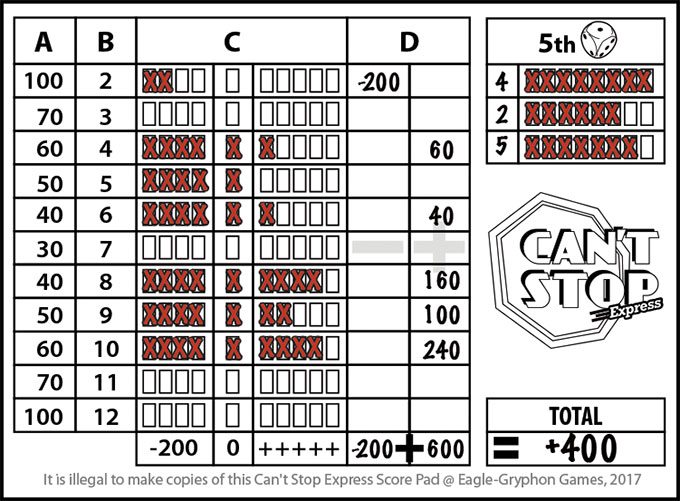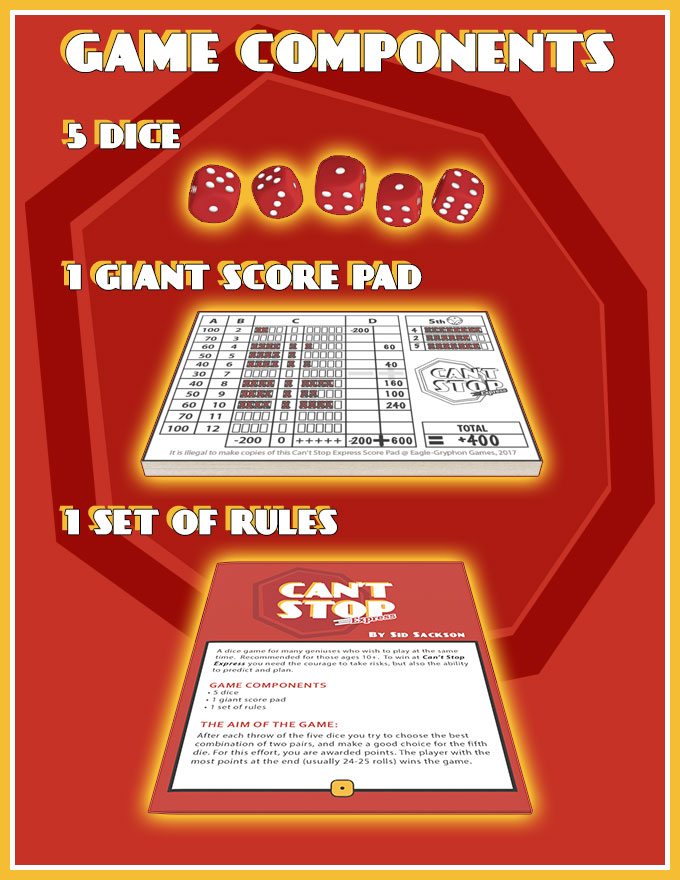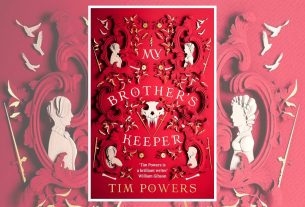Sid Sackson’s classic press-your-luck game gets a fun twist in this dice-rolling game for any number of players: Can’t Stop Express.
At a glance: Can’t Stop Express is for any number of players, ages 10 and up, and takes about 30 minutes to play. It’s currently seeking funding on Kickstarter, with a pledge of $7 for a copy of the game. I think the game could be played by younger kids, with some help—the gameplay rules themselves are simple; scoring requires some arithmetic and strategy requires some understanding of probability.
New to Kickstarter? Check out our crowdfunding primer, and visit our curated page for more projects we love.
Components
The components for this one are pretty simple: 5 six-sided dice and a big scorepad. It’ll all be packaged in one of Eagle-Gryphon Games’ small “EGG” boxes (like Eggs & Empires) so it’s fairly portable. There’s nothing super exciting to see about the components themselves, and they’re simple enough that there aren’t any concerns that manufacturing is going to be difficult. Eagle-Gryphon Games generally has a nice quality to their components. Of course, in this game you’ll use up the scorepads as you play, so eventually you’ll need to replace them.
How to Play
You can download a copy of the rules here.
The goal of the game is to score the most points by choosing the best combinations of pairs when the dice are rolled.
Each player gets a score sheet and something to write with. Players can take turns rolling dice, or you can have the same player roll the dice every time—it doesn’t matter a lot because everyone uses every roll.

On each turn, all five dice are rolled, and then players will choose how to use each of the five dice—as part of a pair, or as the “fifth die,” checking off the appropriate boxes on their score sheets. For a pair, you mark a box in the row corresponding to the sum. For instance, if you pair a 3 and a 5, you would put a checkbox in the row for “8.”
For the fifth die, there are three rows at the top right corner of the scorepad, with 8 checkboxes each. On the first three turns, you write in the number of the die you chose as your fifth die and mark the first box. The trick is, you must choose a different number for the fifth die on the first three turns. From then on, if any of those three numbers is available during a roll, you must choose one of them as your fifth die, and then make pairs with the four remaining dice. If the dice are rolled and none of them show any of your fifth dice numbers, then you get a “free” turn and you just make two pairs and the fifth die is ignored.
When you check the last box in one of your fifth die rows, the game is over for you. Other players will continue until they have checked off a full row in their fifth die sections.
- Here’s how the scoring works. You check each row from 2 to 12, and score points for it, and then total everything up.
- 0 points: If you didn’t check any boxes in a row, or if you checked exactly 5 boxes, you score nothing.
- -200 points: If you checked 1 to 4 boxes in a row, you lose 200 points.
- Positive points: For every checkmark over 5 in a row, you’ll score points as shown on that row. For instance, 2 and 12 are both worth 100 points per check, but 7 is only worth 30 points per check.
You add up your points, and the highest score wins.

The Verdict
The original Can’t Stop is a classic press-your-luck game published in 1980 and designed by Sid Sackson, who was a prolific American game designer. He designed hundreds of games like Acquire, Domination, and BuyWord. Can’t Stop Express reimplements a game originally published in 1989 that has gone by a few different names, including Extra! and Solitaire Dice. It does share some similarities to Can’t Stop, so the rebranding makes sense—plus Can’t Stop is one of Sackson’s most well-known titles.
One of the advantages of Can’t Stop Express is that any number of players can play at the same time (as long as everyone has a score sheet and can see the dice results), and the game doesn’t really take any longer no matter how many players you add. In that, it reminds me a little of 20 Express, another favorite of mine for big groups (see my review here). It’s a good one to kick off a game night before breaking up into smaller groups, or I could also see it work for a classroom activity for teaching kids about probabilities and risk/reward tradeoffs.
The first three turns, you’ll have to make the decision about what three numbers to pick for your “fifth die” section, and those choices will affect you for the rest of the game. For instance, if you choose “1” as one of your numbers, then it will be much harder for you to make low sums like 2 and 3 because you might have to set aside the 1 as your fifth die unless multiple 1s are rolled.
And, of course, the ongoing decisions are how to pair up the remaining dice each turn once you’ve set aside the fifth die. Do you go for the common numbers—7, 8, 9—knowing that you’ll break even more quickly with those, but score fewer points on them? Or do you risk the high-scoring numbers like 2 and 12, at the risk of getting stuck with -200 points instead? The trick seems to be to start as few columns as possible, because every column you start but don’t check at least 5 times will cost you 200 points. On the other hand, sometimes you’ll be forced to start a new column—and each time that happens, you have to make a choice about which one is going to cost you the least. There’s a nice tension there between the more common results and the higher scores.
And of course, there’s the choice of which of your fifth die options to set aside if more than one of them is rolled. Typically we tried to check them as evenly as possible, because as soon as one of those rows is filled up, your game is over. So spreading them out means more opportunities to check off numbers and score. On the other hand, I suppose it’s possible to try ending your game earlier if your score is positive.
I should mention that it took me a few plays before I even broke even, and it’s pretty typical to have a negative score. The rules say that experienced players can expect to get 800 or more points, but we just laugh at that figure. So far the all-time high in my gaming group is 120 points. We’ve had a score as low as -530.
The one thing that is unlike Can’t Stop is that it’s not the same type of press-your-luck. In this one, you’re pressing your luck mostly in what rows you decide to start checking off, hoping that you reach break-even or score for those rows before the game ends. In Can’t Stop, you get to decide on each turn whether to keep rolling or stop, and you risk busting if you keep rolling and get the wrong numbers—thus the name of the game, because often you just can’t stop rolling until you bust. In this game, the title seems less directly connected to the mechanics.
Overall, though, I’ve had a lot of fun playing Can’t Stop Express and—regardless of its relationship to Can’t Stop—I think it’s a really great casual game that forces you to make seemingly simple but excruciating decisions. I love that everyone is invested in every die roll because it keeps everyone engaged throughout the whole game. Now, if I could just get my score above zero…
For more information or to make a pledge, visit the Can’t Stop Express Kickstarter page!
Disclosure: I received a prototype of this game for review.






